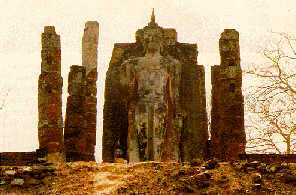|
|
 The Buddha inmage of Wat Saphan Hin |
|
|
| Wat Aranyik Wat Aranyik is located near Wat Saphan Hin in the Aranyik area dwellings places for monks (kuti), caves, and the bases of ubosot and viharn line the pathway to the sanctuary. |
| Wat Chang Rop This is situated in Aranyik area. A chedi is decorated with an elephant emerging from the base. A viham base and laterite columns are in front of the Chedi. |
| Wat Chedi Ngam This is situated on the hill in Aranyik area. The main sanctuary is a round Singhalese-style chedi decorated with four niches. On the east are a viharn and four small stone edifices. On the north is a stone pond. |
| Wat Tham Hip This lies on the hill near Wat Chedi Ngam in the Aranyik area. A viharn and chedi base are still in existence. |
| Phra Ruang Dam This earthenwork dam was formed to hold back water between Phra Bat Yai and Kiu Ai Ma Hills and restored by Thailand's Irrigation Department. Water from the dam will be used as replacement whenever the water level in other reservoirs goes down. This dam is referred to in the Sukhothai inscription. |
| Wat Mangkon A big viharn and a round Singhalese-style chedi are visible. Sangkhalok architectural decorations were found here. |
| Wat Phra Yun This lies some 2,500 meters west of Wat Mahathat. The viharn enshrines a standing Buddha image. |
| Ho Thewalai Kasetra Phiman The palace of the god in the field near Wat Pa Ma Muang is a square laterite triple-tiered pedestal. Its form resembles that of a mondop and was probably used to install Hindu images. |
| Wat Pa Ma Muang The sanctuary of the Mango Grove is an important one referred to in Sukhothai inscriptions. The base of the Singhalese-style chedi and the ubosot still exist. |
| Wat Tuk This lies about 110 meters from Ho Thewalai. A square window-less mondop is the main sanctuary; a viharn and chedis are in front. |
| Outside the Citywalls : North Wat Phra Phai Luang This temple lies about 500 meters north of San Luang Gate. This sanctuary, formerly a Khmer-Hindu shrine, but later coverted into the Buddhist monastery, is surrounded by a moat. It is second in importance to Wat Mahathat. Inside there are three prangs like Wat Si Sawai, but the southern and the central ones, have crumbled, leaving only the northern one decorated with stucco figures. In front of these prangs are a viharn and a crumbled chedi; the later has a pedestal decorated with stucco seated Buddha images. A mondop contains Buddha images in four postures; sitting, reclining, standing and walking. They are now all in ruins. A Sivalinga (Phallic emblem of Siva) was unearthed in the compound of this sanctuary. |
| Wat Sangkhawat This lies about 1,980 meters north of Wat Mahathat. The viharn enshrines a stucco image of Sukhothai style. Behind stands a Singhalese-style chedi. To the south, a brick ubosot base is surrounded by slate semas. |
| Wat Hin Tang This lies about 2,400 meters north of Wat Mahathat. The Singhalese-style brick chedi is supported by a laterite base and surrounded by a laterite wall. A Sukhothai inscription of Wat Hin Tang described Buddhist relics and religious rites. |
| Wat Khung Wai This lies about 300 meters away from Wat Hin Tang. |
| Wat Si Chum This lies about 1,500 meters north of Wat Mahathat and was originally surrounded by a moat. A square mondop is the main sanctuary and contains a monumental stucco-over-brick Buddha image in the attitude Subduing Mara, called "Phra Achana". This Buddha measures 11.30 meters from knee to knee. The mondop is 32 meters square and 15 meters high, and the walls are 3 meters thick. There is a passageway in the left inner wall itself which leads to the above crossbeam. On the ceiling of the passageway are more than fifty engraved slate slabs illustrating Jataka scenes. |
| Outside the Citywalls : South Wat Ton Chan This is situated outside the southern city wall 1,150 meters away from Wat Mahathat. A Brick Singhalese-style chedi enshrines Buddha images in niches. The brick viharn contains a handless stucco Buddha image. Fine votive tablets called Sanaechan are found here. |
| Wat Chetuphon A mondop enshrines four Buddha images in different postures: sitting, standing, walking and reclining. The outer walls of the mondop still retains a section in the form of slate pillar-balustraded window. There is an entrance to the mondop on the north. Just behind the mondop is a small sanctuary which contains a Buddha image known locally as Phra Si Ariya (Matireya), the Lord Buddha of the Future. |
| Wat Si Phichit Kirati Kanlayaram Wat Si Phichit Kirati Kanlayaram with a round Singhalese-style chedi on a square pedestal and a viharn in front, is surrounded by moats. A borken stone inscription in Pali and Thai was found and might have been inscribed between 1400- 1404. |
| Wat Wihan Thong or Wat Thaksinaram This is situated nearby Wat Asokaram. The main sanctuary is the brick lotus-bud shape chedi. |
| Wat Asokaram (Wat Salatdai) This large monument is situated outside the southern city wall 1,400 meters away from Wat Mahathat The bases of the main chedi, the viharn and the mondop are visible. |
|
Wat Mumlangka
|
|
Outside the Citywalls : East
Wat Chang Lom
|
|
Wat Thraphang Thong Lang
|
|
Wat Chedi Sung
|
|
Wat Hot Phayom
|
|
Wat Ko Mai Daeng
|
|
Amphoe Muang
|
|
Amphoe Sawankhalok
|
|
Amphoe Khiri Mat
|